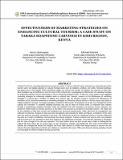| dc.description.abstract | Cultural Tourism is a growing phenomenon around the world. In Kenya, cultural tourism represents an important part of the
tourism sector and largely depends on cultural heritage assets such as traditions, artifacts, and crafts, historical buildings,
and gastronomy of host people. While marketing strategy can enhance the number of visitation and revenues to these sites,
other strategies may be ineffective to meet the aims of the cultural sites. Investigating the effectiveness of marketing strategies
on enhancing cultural Tourism should play a role in enhancing visitation levels. To this end, some authors have suggested
marketing strategies for enhancing visitation levels in cultural sites; however, research on the effectiveness of marketing
strategies in cultural sites is limited. To address this research gap, the research sought to examine the effectiveness of
promotion, price, and brand awareness as marketing strategies on enhancing cultural tourism in Kenya using a case study on
Tabaka soapstone carvings. The target population consisted of 300 tourists, 30 employees at the site, and management of the
cultural site committee. A stratified sampling technique was used to select 60 tourists while 10 employees were selected
through a proportionate sampling technique. Data was collected from both secondary and primary sources. However, the
researcher relied mostly on primary sources as it was taken to be accurate as compared to secondary sources. The major tool
for the collection of data from tourists and employees was structured questionnaire, while, data from the management was
collected via interview. Analysis of data was done descriptively and presented by tables and figures. Limitations of the study
were also explored and ethics considered in the study. The study found out that an inadequate number of tourists visiting the
site were as a result of ineffective communication techniques employed. Tourism products and services were not presented
well to tourists as it was promised to them thus leading to low satisfaction of tourists. They had also developed a perception
that the price charged at the site was expensive. The study farther found out that tourists were unable to distinguish the
cultural site from others due to unclear logos on site’s brochures, websites, and signboards. The study recommended that
cultural site management should use websites and local radio stations to enable more target tourists to discover the site
instead of tourists depending on friends and relatives as revealed by the study. Offers and discounts during weekdays should
be encouraged to enhance visitation during such periods. | en_US |

